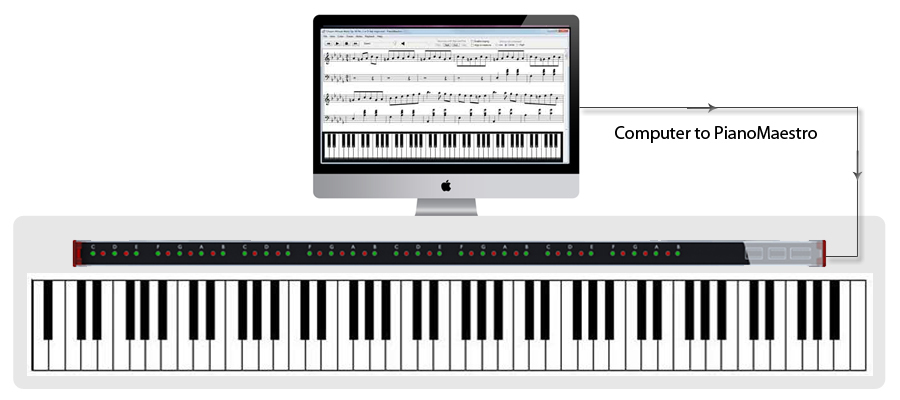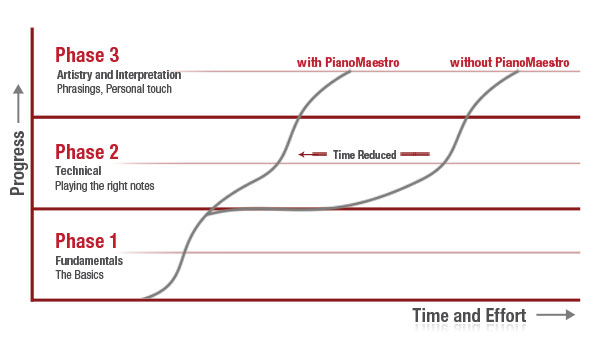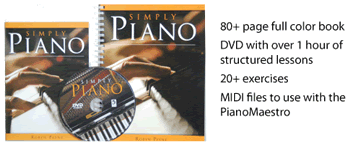What is PianoMaestro?
PianoMaestro is a portable electronic USB device for learning how to play the piano.
The PianoMaestro® learning system is comprised of (1) a computer program that reads standard MIDI files and displays the notes on the screen and (2) a ruler-like strip of lights that is placed of the black keys of any acoustic or digital piano. PianoMaestro®’s 48 lights correspond to the keys on your piano, indicating which keys to play at the right time. The PianoMaestro connects to your computer via the USB port. You can study and follow the music score on your computer screen. With a few mouse clicks, you can adjust the playback speed and repeat a few notes at time.

Accomplish More
The PianoMaestro’s software has powerful features to help you confidently master the pieces you have always dreamed of playing.
- Watch the notes on the computer screen. Look for patterns.
- Repeat sections over and over until committed to muscle memory
- Slow down the playback speed
- Separate the left and right hands. Practice each hand separately
Students motivated by their accelerated progress will spend more time playing the piano.

Save Time
Owning a PianoMaestro is like having a piano teacher 24 hours a day, 7 days a week to show you how to play any piano piece.
Learning the notes of a new song – Phase 2 in the graph – is the most time consuming and frustrating part of learning to play the piano. Hours of practice can yield disappointing results. Many students give up.
The PianoMaestro enables students to master new piano pieces more quickly and more efficiently by reducing the time required to learn the notes in a song. Students can then spend more valuable piano instructor time focusing on the artistry and interpretation of a piece.
Students using the PianoMaestro are rewarded sooner with the ability to play the music they love.

Save Money
The PianoMaestro is designed to add guide-light technology to the piano that you already own. The PianoMaestro works with readily available computers running Windows. You can have the benefits of guide-lights for 1/20th the cost of purchasing a new digital piano with the guide-lights built in. Because a student can learn to play the notes faster with the aide of the PianoMaestro, the student can spend more valuable lesson time perfecting a piece.

Thousands of Songs Available
The PianoMaestro reads standard MIDI files. PianoMaestro does not have its own proprietary data format. This means that there are thousands if not millions of songs available to download from the internet. The PianoMaestro comes with more than 250 songs from the masters:
- Bach
- Beethoven
- Brahms
- Chopin
- Debussy
- Granados
- Liszt
- Mozart
- Schubert
- Tschaikovsky
- And others
Please see the complete song list here.

Resources for Beginners
If you are new to the piano, a qualified piano teacher is invaluable for learning the proper techniques that will serve as the foundation for your further studies.
To this end, PianoMaestro is excited to be working with Robyn Payne – well-known Australian composer, producer, and author of Simply Piano. Simply Piano is a book and DVD set that provides a comprehensive introduction to the piano. Produced with the beginner in mind, Simply Piano includes a DVD with over an hour of structured piano lessons and an 80 page full-colour book.
Simply Piano covers essentials such as posture, hand position, finger independence, scales and chords through 21 exercises that progresses from popular classics to improvisation.
The Simply Piano exercises are available for free in MIDI format for use on the PianoMaestro. To maximize the impact of these exercises, we suggest investing in a copy of Simply Piano. In the DVD, Robyn is your personal piano teacher who will guide you through the exercises, providing the context and purpose of each exercise and highlighting common mistakes. The book provides tips for reading music, music theory, rules for chord progressions and improvisation, and other topics. Simply Piano provides important elements for learning the piano that can not be conveyed in MIDI files alone.

Muscle Memory
What does skiing, basket ball, ballet dance and playing the piano have in common?
Answer: muscle memory.
If you are proficient at a sport or performance art, you know what it is like to be in the “zone”. Your mind is in a relaxed state. Your muscles take high level instructions from your brain and then execute them smoothly without additional thought. A professional golfer or ballet dancer can not possibly process step-by-step instructions with his or her brain. The response time is not fast enough. Athletes train by drilling and drilling and drilling some more. All this hard work pays off when these movements are stored in muscle-memory – where information takes the much shorter route of going to the spinal chord and back instead of all the way up to the brain.
The same is true for playing the piano.
Watch Tommy play this very fast Chopin piece. Watch his eyes – can tell that he is in the “zone”
To play like Tommy, you need to memorize the piece. Have you ever been to a concert where the pianist had sheet music in front of him?
To memorize a piano piece, you need to repeat it over and over again until it becomes second nature. Reading music notation and playing by ear are two very ways to commit a song to muscle memory.
For the last 400 years these were really the only two methods available. With the PianoMaestro, you now have a third.
Our Story
The PianoMaestro Story
In 2009, Ken bought a piano and starting taking piano lessons with the romantic idea that he would fill his Australian home with the sounds of Beethoven and Bach. Ken had not touched a piano for 15 years and st ruggled to read and play the right notes.
While searching for a way to improve his piano skills, Ken noticed an abundance of old pianos (pianos have an average life in excess of 50 years) and inexpensive laptop computers. This inspired Ken to try to connect the two, resulting in the PIanoMaestro.
Ken hopes that the PianoMaestro will inspire more children and adults to take up the piano, and that the millions of old pianos collecting dust in living rooms around the world will have a chance to make music again.
Our Team

Ken Ihara. Inventor, Product Design
Ken oversees all aspects of PianoMaestro, with a focus on product development and operations. Prior to founding PianoMaestro, Ken spent 9 years in corporate finance in New York and London at Citigroup. Ken was a Vice President in Investment Banking, where he worked on numerous M&A and financing transactions in the automotive and industrials sector.
Ken studied electrical engineering at Harvard University, where he developed his electronics and computer programming skills building electronic devices at the Harvard Robotics Laboratory.

Amr Salah El-din Hassan. Technology
Amr is responsible for software development of the PianoMaestro. Prior to joining PianoMaestro, Amr has worked on software projects in the banking and microchip fabrication industries. Amr has a bachelors degree in Computer Engineering from Cairo University’s Faculty of Engineering.

Avril Redmond. Business Development
Avril is responsible for PianoMaestro’s sales and business development. Prior to joining PianoMaestro Avril spent 8 years working with business start ups, family run businesses and global companies in marketing and sales capacities.
Avril has a bachelors degree in Marketing from the Marketing Institute of Ireland and a Diploma in e-commerce. Avril is also developing a business importing products from Europe which she is launching later this year.

Linh Hoang. Marketing
Linh oversees PianoMaestro’s online marketing strategy, business operations, and procurement activities. Linh has developed several online businesses since 2008, including www.chimeracc.com (Australian nail polish brand) and www.world-famous-quotes.com. Prior to starting her own businesses, Linh spent 3 years in supply chain management at BAE Systems. Linh has a Bachelors Degree in International Business.

